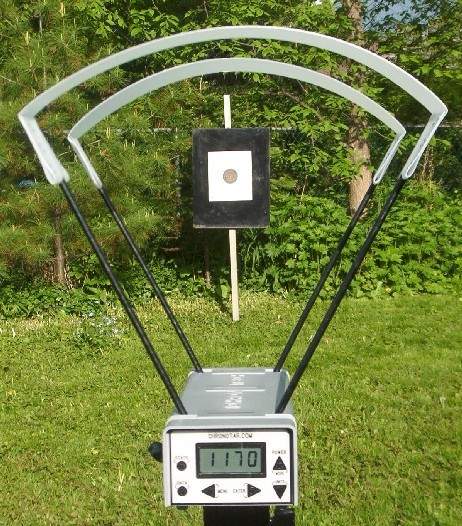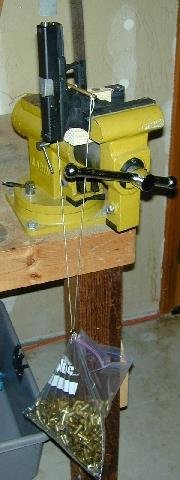
This website features quite a few reviews of airsoft guns now and, as well as descriptions and views of the guns, I also try and carry out a number of objective tests of weight (simply weighing), accuracy, velocity and trigger pull weight.
The tests are carried out as follows, for those interested or who may like to reproduce them for themselves.
Star Ratings
These are subjective scores given for :
- Realism : Does it look realistic? Is the operation realistic? Are the trademarks true to the original?
- Quality : Is it well made? Are the materials used good quality? Is the moulding crisp and seam free? Did it operate correctly?
- Power : A rising scale, but taking into account the type of gun.
- Accuracy : Based mainly on the 5m test, but allowing for extenuating circumstances and/or good or bad performance in range, for instance or badly off aimpoint sights.
Scores tend to consider price and type of gun, too, so a 200fps springer COULD be a 4 star gun and a 250 fps GBB only a 3 star.
They really just give a taster of where a gun is good or bad. Obviously, guns which score well in all categories are better, but a gun may look great and perform averagely or vice versa.
Weight
This one is simple. I just take the gun, with magazine and drop it on my weighing scales.
In 2005, I started weighing the magazine separately as TM seems to have started weighting them, which gives a good all up weight, but
an odd balance to the pistol.
Accuracy
This test is carried out using 'The Invader' (IDPA-Target.jpg) target from www.ammoman.com, which I print out, scaled to fit, on A4 paper, although printing on the US Letter format would not dramatically alter the test.
I set the target up (inside my garage, to avoid wind disturbance) at 5m from the shooting point.
I use .25g BBs for the test, since they fly a little flatter, unless otherwise noted.
I don't bench rest the gun. When I originally suggested this method for testing accuracy there was a degree of criticism on the forums with people suggesting it would not be reliable. However, the aim of the test is to assess the degree of accuracy one can achieve when firing the gun as one would in competition or a skirmish and, therefore, all testing is done firing the gun, off hand, with a double handed grip.
Reading through gun magazines, notably Handguns, bench testing is usually reserved for testing the relative performance of different bullets and powder charges, rather than assessing the performance of a handgun in, as is intended, the hand.
For gas guns, I record the gas type and temperature, as well as BB weight as higher FPS may provide different trajectories.
Velocity
For a long time, people asked "How powerful is XYZ?" when I posted a review, but I was only able to provide a subjective comparison with other guns. I tried to obtain a Combro (which had been out of production for around a year at the time of writing, but was rereleased later), which fits on the end of the barrel, but I was not able to find one. However, whilst looking on eBay, I came across the Chronotar company.
A new CE-2 "shoot through" chronograph offered lots of features (most of which I admit I don't use), for less than the going price of a Combro (even including postage from Canada, where Chronotar are based). One of the moderators over on Airsoft Retreat has the (slightly) more basic CE-1 model and reports it to be accurate with known good chronos.

Whilst I rarely have the chance to check the reviewed guns against other chronos, the general level of measured velocity is on a par with other recorded results, so I have no reason to doubt that the unit is accurate and tests with the same gun, under similar conditions, produce consistent results.
The Chronotar is also good in that it works exceptionally well under low light conditions. Well enough, in fact, that I can test indoors, with the unit directly under a single 100 watt bulb.
I always test velocity with .2g Excel BBs (the standard weight for chrono testing, where 1 Joule = 328fps).
For gas guns, I record the ambient temperture and gas type used for the velocity testing. The gas used is either dependant upon the weather or what I happen to have to hand.
Initially, I tended to use Abbey 134a or Cybergun Winter gas. The Winter gas, typically, produces around 40 fps more velocity than 134a. Ambient temperature is important as 200fps at 16C is not comparable with 200fps at 21C, as any gas will produce more pressure at higher temperatures.
Since 2006, I have tended to use Propane or Green Gasses of various types, except when it is exceptionally warm. Propane is generally considered to be the main constituent of Green Gas and produces FPS figures directly in line with Green Gas, in my experience.
Trigger Pull Weight
I got the idea for adding this test after testing a couple of KSC M945s. I noticed that these guns have exceptionally light feeling triggers. Looking around the web for suggestions of how I could measure this aspect, I came across this website..
It seemed to offer a simple and cheap solution, so I set to work producing a test rig. As cartridges require a Firearms Certificate in the UK, I decided to use Steel M6 woodscrews. These are cheap, fairly light and easily obtained.
I rigged up a tin, suspended by thin wire loops. These loops then fit into notches in the ends a brass tube, which I rest across the trigger.

The tests are carried out with the hammer cocked (in single action mode) as the weight to operate double action is much higher and single action is a consistent mode across most guns and types (spring, gas, revolver, automatic) and the magazine out.
The gun is tilted into a 90 degree upward position and screws are added, in small numbers until the trigger releases the hammer.
The tin and screws in it are then weighed to determine the approximate pull weight of the trigger.
I was a bit concerned, initially, that this was a bit 'home brew', but I found another website, containing rules for a competitive shooting series (which I cannot find again at the moment), which used an almost identical setup (with set weights) for ensuring trigger weights for competition guns, so I feel it has some validity.
There are mechanical and digital trigger pull meters (which are basically spring gauges with tell-tales), so I may invest in one of these at some point. As an alternative, digital fishing scales look very similar to the digital trigger pull gauges, but don't know if they record the maximum pull weight, which would be required to ensure they could be used instead. If anyone has a digital fishing scale, that they know can be set to record peak weight (ie the maximum recorded, rather than being able to store a selected weight), please get in touch.
Back to the Homepage